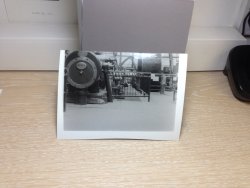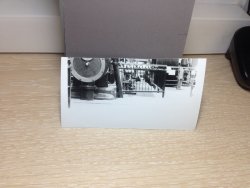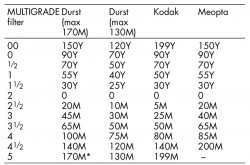Is it possible that the paper is fogged, not with the safelights, but due to incorrect storage, or day I say it age? I have some Jessops multigrade from I don't know how long ago....... and it's unusable. I have some benzatriozole, but I have never actually tried it to cut down on the fog.
-
Thank You For Visiting... Please Click Here and sign up to contribute and reply to posts and download the resources.
You are using an out of date browser. It may not display this or other websites correctly.
You should upgrade or use an alternative browser.
You should upgrade or use an alternative browser.
How Would You Tackle This
- Thread starter Ian-Barber
- Start date
- Joined
- Aug 6, 2016
- Messages
- 1,586
UPDATE
I decided to try something else...
Here is my Grade 5 (12 seconds) using the under the lens Ilford Filter

I then removed the Ilford filter and dialled in MAX Magenta on the enlarger head and this is the result (12 seconds)

This is indicating to me that the under lens filter is not doing its job properly. Have these filters changed over time, these were bought a few years ago second hand from eBay
I decided to try something else...
Here is my Grade 5 (12 seconds) using the under the lens Ilford Filter

I then removed the Ilford filter and dialled in MAX Magenta on the enlarger head and this is the result (12 seconds)

This is indicating to me that the under lens filter is not doing its job properly. Have these filters changed over time, these were bought a few years ago second hand from eBay
- Joined
- Dec 19, 2017
- Messages
- 2,712
Filters do fade, you may also have the older filter set from the third generation Multigrade.
The first Multigrade was introduced in 1940 but wasn't around long, the second generation was 1953 and was discontinued by the time I began serious darkroom work in the late 1960's. These papers used Yellow filtration to increase contrast, Magenta for Soft grades.
When Ilford re-introduced Multigrade in 1979 it was significantly better than previous versions and soon began to replace graded papers. Now using Magenta filters for Contrast, Yellow for Soft, thee have been various filter sets, these changed significantly with Multigrade IV.
You are better using the colour head rather than filters.
Ian
The first Multigrade was introduced in 1940 but wasn't around long, the second generation was 1953 and was discontinued by the time I began serious darkroom work in the late 1960's. These papers used Yellow filtration to increase contrast, Magenta for Soft grades.
When Ilford re-introduced Multigrade in 1979 it was significantly better than previous versions and soon began to replace graded papers. Now using Magenta filters for Contrast, Yellow for Soft, thee have been various filter sets, these changed significantly with Multigrade IV.
You are better using the colour head rather than filters.
Ian
- Joined
- Aug 6, 2016
- Messages
- 1,586
You are better using the colour head rather than filters.
Just reading the data sheet for MG papers. My JOBO C6600 falls under the KODAK column I believe.
From the table below, read off the approximate filtration needed for each contrast step.
However, as the yellow and magenta filters have not been arranged to equalise exposures, new exposure times will have to be recalculated when the contrast is changed.
Is there any formula which you can use to work out new exposure time if moving grades or do you have to perform a new test strip each time

- Joined
- Dec 19, 2017
- Messages
- 2,712
Ilford do have another chart. This one is dual filtration, there will be slight exposure adjustments needed but not as significant compared to one filter.
Ian
Ian
- Joined
- Aug 6, 2016
- Messages
- 1,586
Ian, I noticed you had a JOBO C6600 in your darkroom. Have you tried it using under the lens filters for bw ?
- Joined
- Dec 19, 2017
- Messages
- 2,712
No, I've always uses the built in filtration because it's easier. I have used below the larger filters with a Durst in the filter drawer, and the below lens set with a Johnsons V45. with no problems.
I prefer to just dial in single filtration but that's how I'm used to working.
Ian
I prefer to just dial in single filtration but that's how I'm used to working.
Ian
- Joined
- Aug 6, 2016
- Messages
- 1,586
NOW SOLVED
The ILFORD under lens filters have been causing the problem all along. Either they are worn out or they may be an earlier version which is not compatible with the MG papers available today.
Thanks to everyone for helping me get to the cause of the issue.
The ILFORD under lens filters have been causing the problem all along. Either they are worn out or they may be an earlier version which is not compatible with the MG papers available today.
Thanks to everyone for helping me get to the cause of the issue.
It would be good to see the proper print made with the proper filters.
If there others in the series, it would be good to see the whole set too.
Just to satisfy my curiosity: why use below-the-lens filters on a colour-head enlarger?
If there others in the series, it would be good to see the whole set too.
Just to satisfy my curiosity: why use below-the-lens filters on a colour-head enlarger?
- Joined
- Aug 6, 2016
- Messages
- 1,586
Just to satisfy my curiosity: why use below-the-lens filters on a colour-head enlarger?
I was led to believe that the filter in the colour head where more geared towards colour printing and under the lens filters for black and white gave a closer match to Grades and better contrast.
What I have learnt on this long journey trying to figure out as to why I just could get get the contrast up is the fact that over the years, I was not aware that there have been variations of the Ilford under the lens filters.
As these were purchased second hand and not knowing the history it appears that for what ever reason, they are just not working with the MG paper I am using, this may be due to the fact that they are worn out or the fact that they be an earlier vein not compatible with modern papers.
- Joined
- Sep 22, 2017
- Messages
- 300
I have 3 filter kits from different ages min. up to 15 years old and had never ever issues with'em but I use only opal bulbs in my enlargers.
Now after buying a De Vere with color head and 2 power bulbs I'll have to test this at my own.
Not knowing which wavelength of light bulbs have I admit there will be differences to be tested.
A friend of mine uses a durst enlarger with a color head and he also sometimes struggles with prints.
Now after buying a De Vere with color head and 2 power bulbs I'll have to test this at my own.
Not knowing which wavelength of light bulbs have I admit there will be differences to be tested.
A friend of mine uses a durst enlarger with a color head and he also sometimes struggles with prints.
Last edited:
Although it's convenient to think of exact contrast steps in the way we used to think of graded papers, the contrast varies continuously.
Consequently, it's possible to print directly with the numbers on the colour head, whatever they may be. If the contrast at say, 30M is too low, then 60M might be better. (These are only example figures of course) If you are printing on the same enlarger, on the same paper(s) it's not difficult to tune your eye to this.
There are tables of equivalents for different enlargers and they are clearly useful, but they are contrived to meet two criteria. Firstly, as you'd expect, to give predictable changes in contrast, but secondly to give constant exposure times in the same way as the under-the-lens filter set. (There are also over-the-lens sets for enlargers with a filter drawer.) In this way, some of the light is necessarily "wasted" to even out the exposure times.
When I was printing regularly in the darkroom, I found it perfectly convenient to print using the filters directly. It has to be said that for radical changes in contrast, a new test-strip is needed, but in my view a radical change in contrast changes the aesthetic values so much that it needs to be treated as a new print.
I've always fancied the Ilford Multigrade head, but it's always seemed just a little bit ahead of what my pocket-money could stand.
Addendum: I forgot to say, the filter values are the same for any kind of colour generation, just as inches are the same on any kind of rule, so any way of creating them should work equally well. Phillips made an enlarger which used complementary colours instead of CMY and it seemed to work well.
Consequently, it's possible to print directly with the numbers on the colour head, whatever they may be. If the contrast at say, 30M is too low, then 60M might be better. (These are only example figures of course) If you are printing on the same enlarger, on the same paper(s) it's not difficult to tune your eye to this.
There are tables of equivalents for different enlargers and they are clearly useful, but they are contrived to meet two criteria. Firstly, as you'd expect, to give predictable changes in contrast, but secondly to give constant exposure times in the same way as the under-the-lens filter set. (There are also over-the-lens sets for enlargers with a filter drawer.) In this way, some of the light is necessarily "wasted" to even out the exposure times.
When I was printing regularly in the darkroom, I found it perfectly convenient to print using the filters directly. It has to be said that for radical changes in contrast, a new test-strip is needed, but in my view a radical change in contrast changes the aesthetic values so much that it needs to be treated as a new print.
I've always fancied the Ilford Multigrade head, but it's always seemed just a little bit ahead of what my pocket-money could stand.
Addendum: I forgot to say, the filter values are the same for any kind of colour generation, just as inches are the same on any kind of rule, so any way of creating them should work equally well. Phillips made an enlarger which used complementary colours instead of CMY and it seemed to work well.
Last edited:
- Joined
- Dec 19, 2017
- Messages
- 2,712
I have 3 filter kits from different ages min. up to 15 years old and had never ever issues with'em but I use only opal bulbs in my enlargers.
Now after buying a De Vere with color head and 2 power bulbs I'll have to test this at my own.
Not knowing which wavelength of light bulbs have I admit there will be differences to be tested.
A friend of mine uses a durst enlarger with a color head and he also sometimes struggles with prints.
I use both a De Vere and a Durst with colour heads and have no problems with them and MG papers, you won't have any issues. In theory you should make slightly more contrasty negatives for a diffuser enlarger but I never have.
Ian
- Joined
- Aug 6, 2016
- Messages
- 1,586
Just been to see @Keith Haithwaite and do do tests with my under the lens filters and his (both Ilford MG). The difference was chalk and cheese. Even looking at the filters side by side, mine were different in colour. This leads me to think that the filters I have are from an earlier generation.
Last edited:
- Joined
- Aug 6, 2016
- Messages
- 1,586
I use both a De Vere and a Durst with colour heads and have no problems with them and MG papers, you won't have any issues. In theory you should make slightly more contrasty negatives for a diffuser enlarger but I never have.
Ian
Ian, do you prefer the single filter approach or the dual filter approach the using the filters in the head
- Joined
- Dec 19, 2017
- Messages
- 2,712
Ian, do you prefer the single filter approach or the dual filter approach the using the filters in the head
I've always just used a single filter as it's easier, I don't use the Grade table either but that's just years of experience using MG papers going back to around 1979.
Ian

